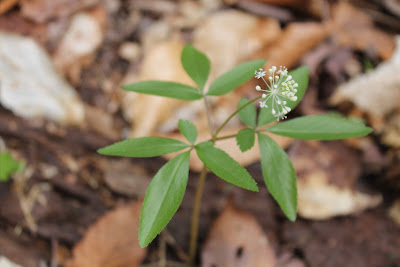Friday, July 1, 2016
EXPLORING THE NIAGARA FRONTIER: Dwarf ginseng
Ginseng is one of the more common herbal supplements on the market. The global demand for the magical root (it can allegedly increase memory, concentration, immunity and libido while decreasing blood sugar) exceeds $2.2 billion annually.
That has caused some exploitation of wild populations of the plant, with the large American ginseng especially taking a beating. Only 19 states now allow its harvest and it is tightly controlled in most jurisdictions.
It can be found in the hills of Western New York’s southern tier, as can its cousin, the dwarf ginseng, which is the plant we’ll look at today.
The Chinese and South Koreans, who really drive the ginseng market, don’t have much need or want for dwarf ginseng. It produces a ball-like tuber, not a multi-rooted one that has the man-like shape that adds to the mythology – and value -- of ginsengs. Also, its medicinal powers are very limited as compared to those of the much larger American ginseng. Despite that, it’s still an incredibly uncommon plant – some folks still harvest it and pass it off as the more-preferred ginsengs and, even if they didn’t, it’s not a plant prone to large populations.
Dwarf ginseng can be found in the cool soils of forests in our hills and their valleys of Allegany and Cattaraugus Counties, especially those with brooks and springs running through them. They appear above ground in late-April and will linger into late June.
It’s a dainty wildflower. The plant will have 3 primary leaves with many having 2 smaller leaflets at the stem. These leaves are not very long, never exceeding 3 inches in length. Nor is the plant tall – a dwarf ginseng might reach a total height of 6 inches, counting the cluster of delicate white flowers that rise above the main plant. Those flowers will become small yellow berries and by the Fourth of July, you typically will find no more evidence of the ginseng above ground.
While Asian consumers might not be impressed by the dwarf ginseng, Native Americans were. They made tea from the leaves, which was used to treat indigestion, gout, hepatitis, rheumatism, and tuberculosis. They chewed on the root to combat headaches, shortness of breath, and fainting.
The root was also a foodstuff for them. The plant is also known as “ground nut”, because the very small tuber (typically no bigger than a grape) has a rich, nutty flavor and could be eaten cold or cooked.
If you encounter one in the wild, let it be. Admire it. Don’t pick it or eat it. Denting the weakened population of this precious plant to taste one or get just a few bucks from its sale is not worth it. They are few and far between in the high country of Western New York and they must be preserved.
Bob Confer is a Gasport resident. His column, Exploring the Niagara Frontier, is published every Thursday on All WNY News.
From the 30 June 2016 All WNY News
Subscribe to:
Post Comments (Atom)


No comments:
Post a Comment